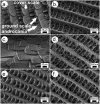Changes in structural and pigmentary colours in response to cold stress in Polyommatus icarus butterflies
- PMID: 28442788
- PMCID: PMC5430924
- DOI: 10.1038/s41598-017-01273-7
Changes in structural and pigmentary colours in response to cold stress in Polyommatus icarus butterflies
Abstract
While numerous papers have investigated the effects of thermal stress on the pigmentary colours of butterfly wings, such studies regarding structural colours are mostly lacking, despite the important role they play in sexual communication. To gain insight into the possible differences between the responses of the two kinds of colouration, we investigated the effects of prolonged cold stress (cooling at 5 °C for up to 62 days) on the pupae of Polyommatus icarus butterflies. The wing surfaces coloured by photonic crystal-type nanoarchitectures (dorsal) and by pigments (ventral) showed markedly different behaviours. The ventral wing surfaces exhibited stress responses proportional in magnitude to the duration of cooling and showed the same trend for all individuals, irrespective of their sex. On the dorsal wing surface of the males, with blue structural colouration, a smaller magnitude response was found with much more pronounced individual variations, possibly revealing hidden genetic variations. Despite the typical, pigmented brown colour of the dorsal wing surface of the females, all cooled females exhibited a certain degree of blue colouration. UV-VIS spectroscopy, optical microscopy, and scanning and transmission electron microscopy were used to evaluate the magnitude and character of the changes induced by the prolonged cold stress.
Conflict of interest statement
The authors declare that they have no competing interests.
Figures








Similar articles
-
Reproducible phenotype alteration due to prolonged cooling of the pupae of Polyommatus icarus butterflies.PLoS One. 2019 Nov 25;14(11):e0225388. doi: 10.1371/journal.pone.0225388. eCollection 2019. PLoS One. 2019. PMID: 31765404 Free PMC article.
-
Spectrally tuned structural and pigmentary coloration of birdwing butterfly wing scales.J R Soc Interface. 2015 Oct 6;12(111):20150717. doi: 10.1098/rsif.2015.0717. J R Soc Interface. 2015. PMID: 26446560 Free PMC article.
-
Biogeographical patterns in the structural blue of male Polyommatus icarus butterflies.Sci Rep. 2019 Feb 20;9(1):2338. doi: 10.1038/s41598-019-38827-w. Sci Rep. 2019. PMID: 30787341 Free PMC article.
-
Multi-instrumental techniques for evaluating butterfly structural colors: A case study on Polyommatus bellargus (Rottemburg, 1775) (Lepidoptera: Lycaenidae: Polyommatinae).Arthropod Struct Dev. 2021 Mar;61:101010. doi: 10.1016/j.asd.2020.101010. Epub 2021 Jan 21. Arthropod Struct Dev. 2021. PMID: 33486292 Review.
-
A protean palette: colour materials and mixing in birds and butterflies.J R Soc Interface. 2009 Apr 6;6 Suppl 2(Suppl 2):S221-31. doi: 10.1098/rsif.2008.0459.focus. Epub 2009 Jan 13. J R Soc Interface. 2009. PMID: 19141430 Free PMC article. Review.
Cited by
-
Humidity-dependent colour change in the green forester moth, Adscita statices.Biol Lett. 2019 Sep 27;15(9):20190516. doi: 10.1098/rsbl.2019.0516. Epub 2019 Sep 18. Biol Lett. 2019. PMID: 31530115 Free PMC article.
-
Phenotypic Plasticity of the Mimetic Swallowtail Butterfly Papilio polytes: Color Pattern Modifications and Their Implications in Mimicry Evolution.Insects. 2022 Jul 19;13(7):649. doi: 10.3390/insects13070649. Insects. 2022. PMID: 35886825 Free PMC article.
-
Breeding Polyommatus icarus Serves as a Large-Scale and Environmentally Friendly Source of Precisely Tuned Photonic Nanoarchitectures.Insects. 2023 Aug 18;14(8):716. doi: 10.3390/insects14080716. Insects. 2023. PMID: 37623426 Free PMC article.
-
Reproducible phenotype alteration due to prolonged cooling of the pupae of Polyommatus icarus butterflies.PLoS One. 2019 Nov 25;14(11):e0225388. doi: 10.1371/journal.pone.0225388. eCollection 2019. PLoS One. 2019. PMID: 31765404 Free PMC article.
-
Spectral tuning of biotemplated ZnO photonic nanoarchitectures for photocatalytic applications.R Soc Open Sci. 2022 Jul 13;9(7):220090. doi: 10.1098/rsos.220090. eCollection 2022 Jul. R Soc Open Sci. 2022. PMID: 35845847 Free PMC article.
References
-
- Nijhout HF. Molecular and physiological basis of colour pattern formation. Adv. Insect Physiol. 2010;38:219–265. doi: 10.1016/S0065-2806(10)38002-7. - DOI
-
- Biró LP, Vigneron JP. Photonic nanoarchitectures in butterflies and beetles: valuable sources for bioinspiration. Laser Photonics Rev. 2011;5:27–51. doi: 10.1002/lpor.200900018. - DOI
-
- Kinoshita, S. Structural Colors in the Realm of Nature (World Scientific Publishing Co. Pte. Ltd., 2008).
-
- Bálint Z, Kertész K, Piszter G, Vértesy Z, Biró LP. The well-tuned blues: the role of structural colours as optical signals in the species recognition of a local butterfly fauna (Lepidoptera: Lycaenidae: Polyommatinae) J. R. Soc., Interface. 2012;9:1745–1756. doi: 10.1098/rsif.2011.0854. - DOI - PMC - PubMed
Publication types
MeSH terms
Substances
LinkOut - more resources
Full Text Sources
Other Literature Sources

